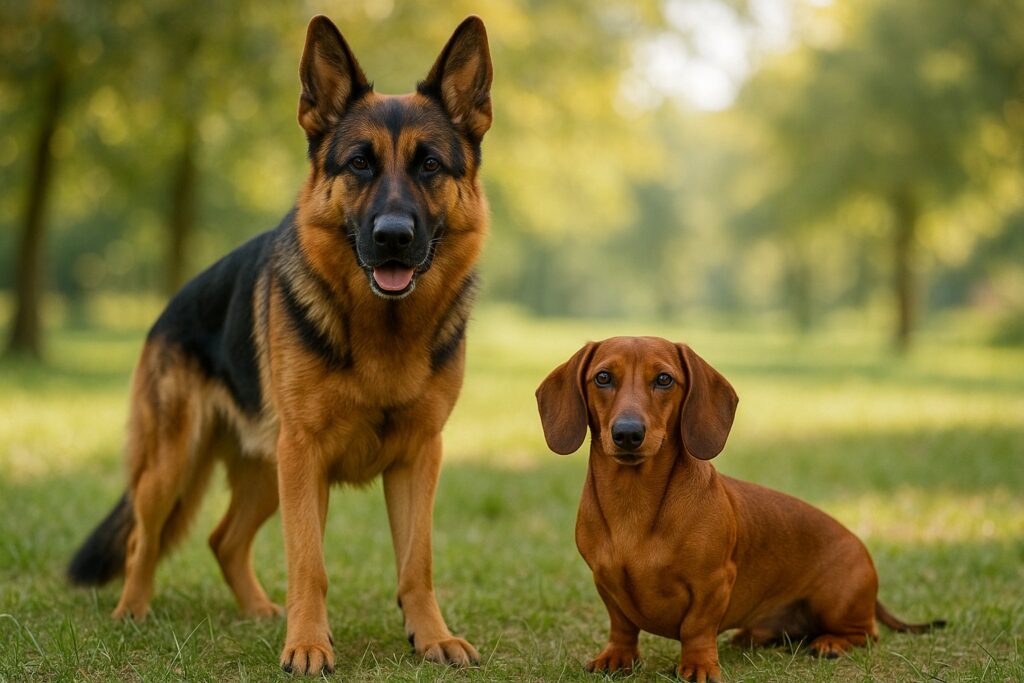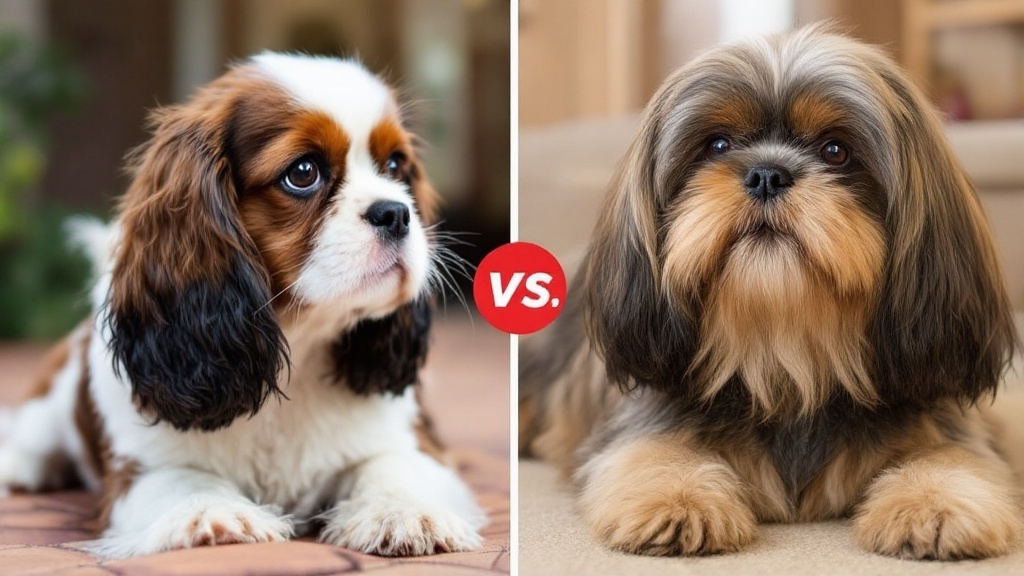Choosing between a German Shepherd and a Dachshund isn’t simple. Both breeds have their own strengths and quirks.
German Shepherds are bigger, protective, and full of energy. Dachshunds are small, clever, and you can’t miss those long bodies.
Knowing these differences helps you figure out which one will fit your home and lifestyle.
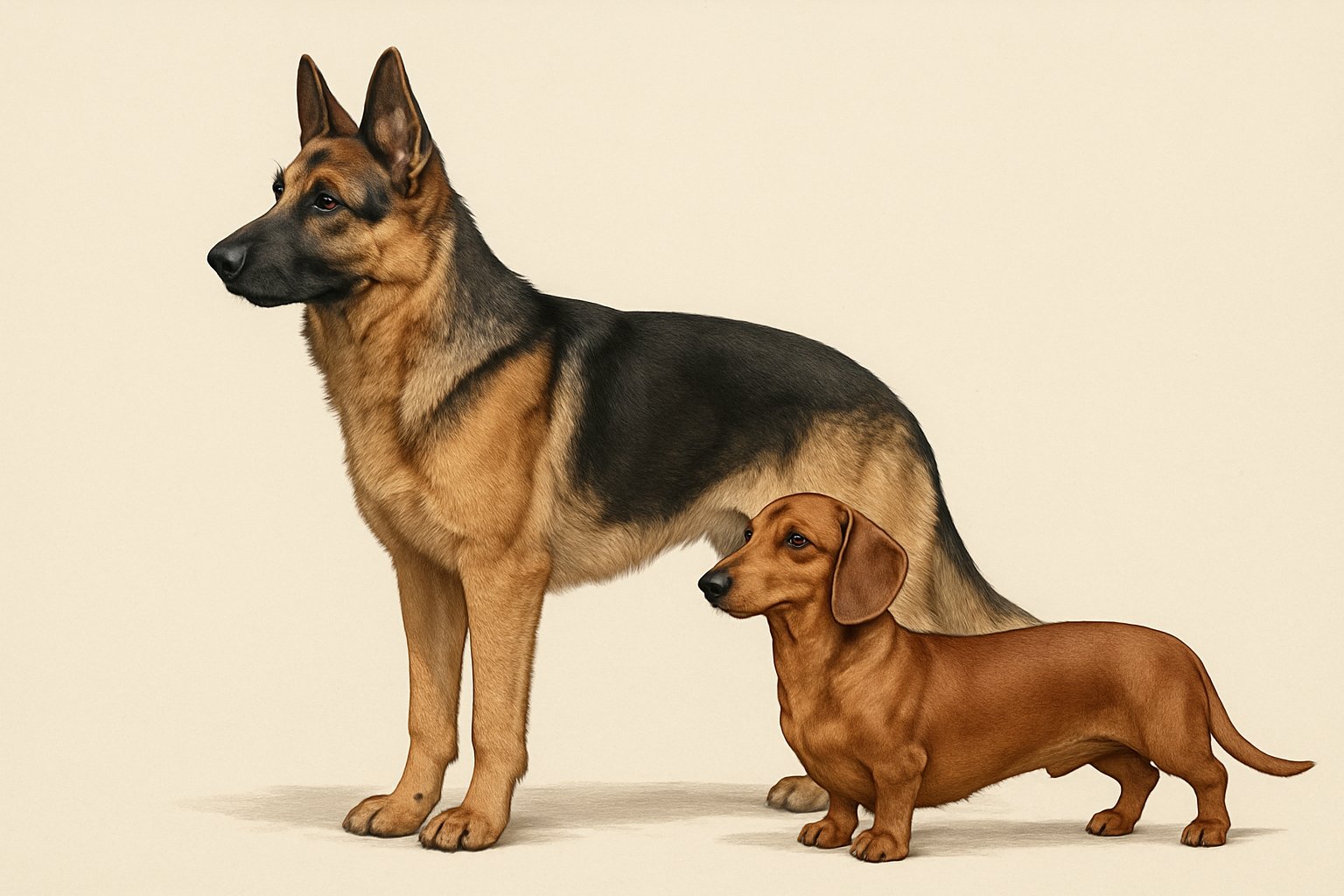
Both breeds have a long history. They were bred for different jobs, and that still shapes their looks, personalities, and even their health needs.
If you’re wondering which breed is better for you, let’s get into it.
Key Takeaways
- Each breed’s background shapes how it acts.
- German Shepherds and Dachshunds differ in size, needs, and personality.
- Understanding these things helps you pick the right dog for your life.
Breed Origins and History
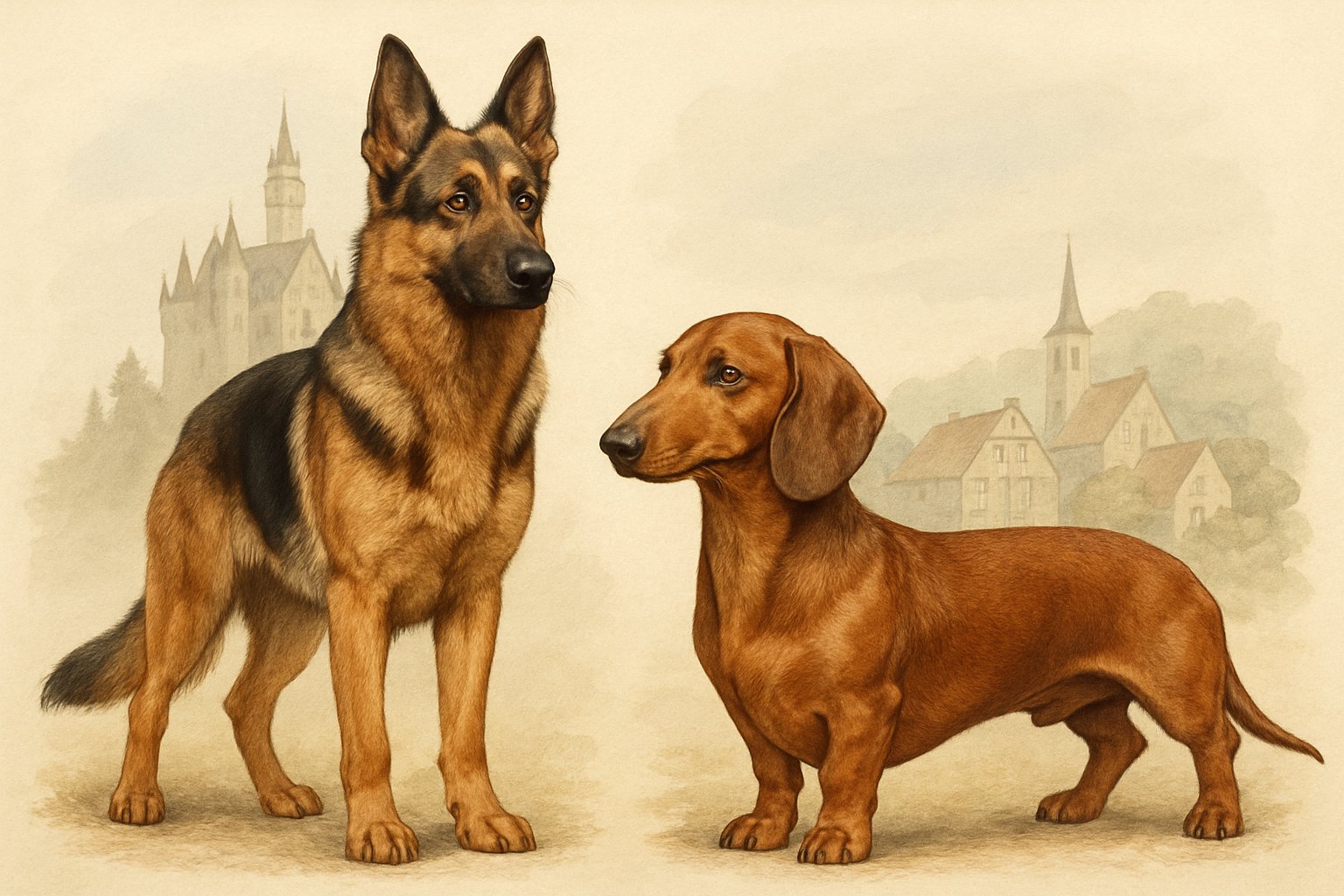
German Shepherds started out as herding and working dogs in Germany. Dachshunds were bred in Europe to hunt burrowing animals like badgers and rabbits.
Both breeds were created for specific jobs. Now, they’re just as likely to be family pets.
Development of the German Shepherd
German Shepherds got their start in Germany in the late 1800s. Max von Stephanitz, a German cavalry officer, wanted to make the perfect herding dog.
He picked dogs for their brains, strength, and loyalty. The breed caught on fast for police and military work because they’re so trainable and brave.
German Shepherds joined the American Kennel Club (AKC) in 1908. These days, you see them as service dogs, in search and rescue, and more.
Key traits:
- Smart and eager to learn
- Strong work ethic
- Great at herding and guarding
Evolution of the Dachshund
Dachshunds go way back in Germany—some say as early as the 1400s. Their name literally means “badger dog” in German.
Hunters liked their long bodies and short legs, which let them chase prey into burrows. By the 1800s, people recognized them as a unique breed.
There are three coat types: smooth, long-haired, and wire-haired. The AKC recognized Dachshunds in 1885.
You can still see their hunting instincts in how determined they are—and in all that digging.
Key features:
- Bold and curious
- Strong sense of smell
- Originally bred for hunting small animals
Physical Characteristics

German Shepherds and Dachshunds look nothing alike. You can spot them instantly by their size, shape, and coats.
Each breed has unique looks that make them stand out.
Size and Appearance
| Breed | Height | Weight | Build |
|---|---|---|---|
| German Shepherd | 22–26 inches | 50–90 pounds | Large, muscular body |
| Dachshund | 5–9 inches (mini) | 11–32 pounds | Long, low-slung body |
German Shepherds are big, strong, and athletic. They stand tall and look alert. Their ears stick up, and their bushy tail is hard to miss.
You’ll notice their deep chest and long legs. They really have a presence.
Dachshunds, sometimes called “wiener dogs,” have those long backs and short legs. Their bodies are so close to the ground, it’s almost funny.
They’ve got droopy ears and usually a cheerful look. For a small dog, they’re surprisingly sturdy.
Coat Types and Colors
German Shepherds have a double coat. The outer part is straight and dense, while the undercoat is soft.
Most are black and tan, but you’ll see sable, black, and even white. The black-and-tan pattern is still the classic look.
Dachshunds come in three coat types: smooth, longhaired, and wirehaired. Smooth Dachshunds have short, shiny fur.
Longhaired ones have soft, flowing hair. Wirehaired Dachshunds are a bit scruffy, with thick, coarse coats.
Coat colors? Tons—red, cream, black and tan, chocolate, dapple. Some have spots or streaks, so every Dachshund looks a little different.
Temperament and Personality
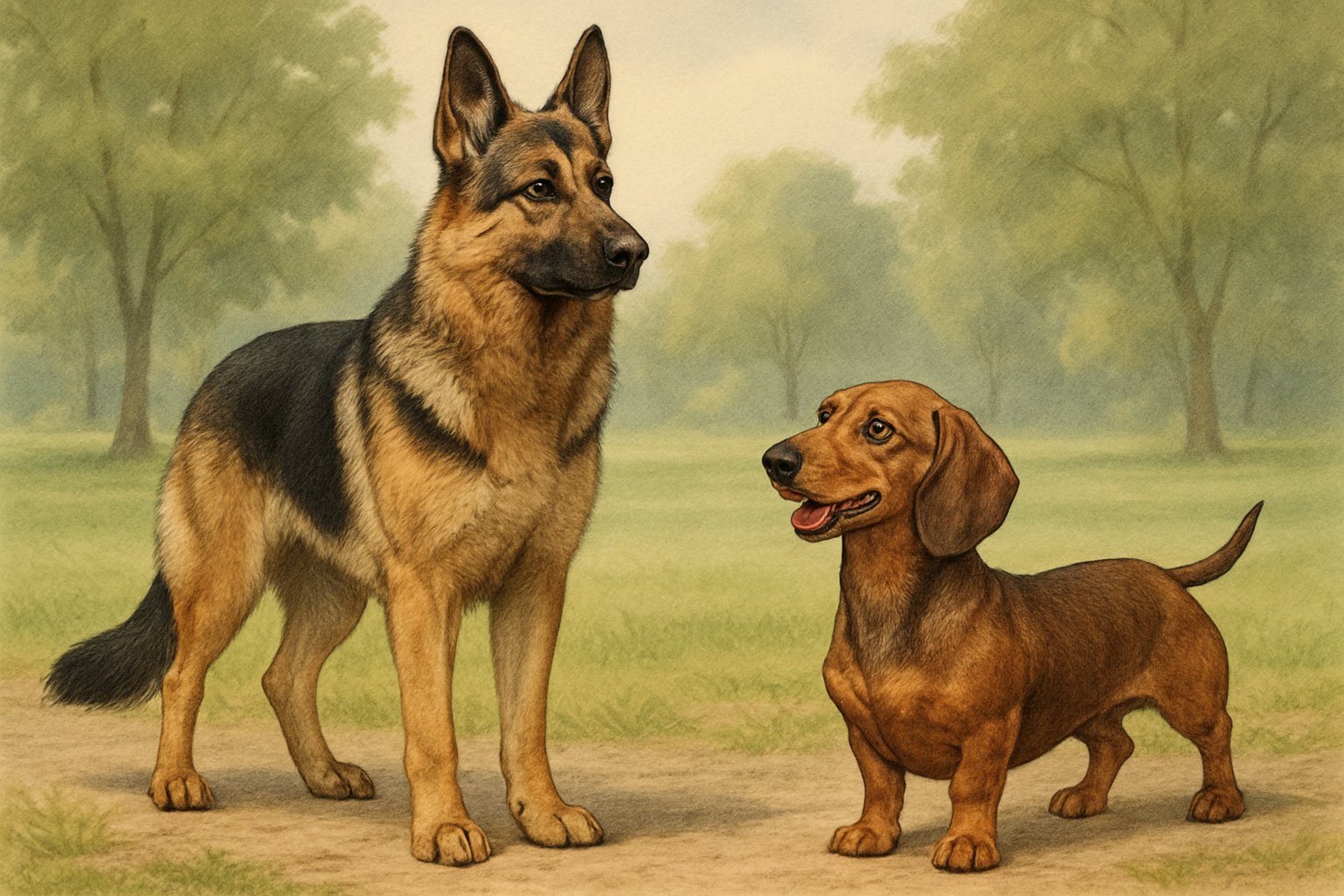
German Shepherds and Dachshunds act pretty differently. They each have their own way with people, pets, and learning new things.
Their personalities can fit different types of families.
Behavior with Families and Children
German Shepherds are loyal and protective. They usually bond with everyone in the family.
They tend to do well with kids, especially if they grow up together. Around strangers, they can get watchful—sometimes that’s good, sometimes it’s a hassle.
Dachshunds are affectionate and love being with their people. They often pick a favorite or two.
They’ll play with older children but might not handle rough play as well as a German Shepherd. Because they’re small, gentle handling is a must.
Both breeds can be good family pets if you introduce them to kids early and socialize them right.
Intelligence and Trainability
German Shepherds are some of the smartest dogs out there. Training them can be a breeze—they love to learn and need something to do.
Stick to consistent commands and use lots of positive reinforcement. They’ll pick things up fast.
Dachshunds are smart too, but stubborn. They were bred to hunt and think for themselves.
Training a Dachshund might test your patience, but treats and praise go a long way. They can surprise you with what they learn when they want to.
| Trait | German Shepherd | Dachshund |
|---|---|---|
| Intelligence | Very High | High |
| Training Difficulty | Low (easy to train) | Moderate (can be stubborn) |
| Task Focus | Strong | Easily distracted |
Poodles and Yorkshire Terriers are clever too, but they might be more energetic or less patient than German Shepherds.
Socialization with Other Pets
German Shepherds can get along with other pets if you start socializing them young. They’re strong and sometimes try to herd smaller animals, so keep an eye on them.
Dachshunds have strong hunting instincts. They might chase small animals, so watch them around rodents, birds, or even tiny dogs like Yorkies.
Dachshunds can get along with other dogs, especially ones with similar energy.
Both breeds do better if they meet new dogs and people regularly. Early socialization classes help a lot.
Proper introductions are important—especially with dogs who have bold personalities.
Exercise and Training Needs
German Shepherds and Dachshunds need different amounts of exercise. Their training styles aren’t the same either.
Activity Levels
German Shepherds need a lot of exercise. You’ll want to give them at least 1-2 hours of walking, running, or play every day.
If they get bored, they might chew or dig. They’re a bit like Dobermans and Boxers in that way—daily activity is a must.
Dachshunds don’t need as much. About 30-60 minutes a day, split between walks and play, usually does the trick.
Because of their short legs, long runs or big jumps aren’t safe for them. Compared to a Lab or Pit Bull, a Dachshund’s energy level is easier for many families.
Table: Typical Daily Exercise Needs
| Breed | Daily Exercise |
|---|---|
| German Shepherd | 1-2 hours |
| Dachshund | 30-60 minutes |
| Labrador Retriever | 1-1.5 hours |
| Boxer | 45-60 minutes |
| Doberman Pinscher | 1-2 hours |
| Pit Bull | 1-2 hours |
Training Approaches
German Shepherds learn fast. They do best with regular, structured training and positive rewards.
Consistency matters—these dogs don’t like harsh corrections. Training methods that work for German Shepherds often help with Dobermans and Boxers too.
Dachshunds can be stubborn, but they love food. Keep sessions short and fun.
Patience and small treats help. Get them used to other dogs and people early on.
Dachshunds, like Labs and Pit Bulls, do well with reward-based training but might need more time to focus. Skip rough corrections—they’ll just get nervous.
Health and Lifespan
German Shepherds and Dachshunds have their own health challenges and life spans. Knowing what to watch for helps you take better care of them.
Common Health Concerns
German Shepherds often struggle with hip and elbow dysplasia. This can cause joint pain and make walking tough.
They can also get degenerative myelopathy, a nerve disease that affects movement. Allergies and digestive issues like bloating pop up too.
Dachshunds are prone to back problems, especially intervertebral disc disease (IVDD), because of their long spines. Extra weight makes it worse.
Dental disease and heart problems show up in older Dachshunds.
Some other breeds have their own issues. Shih Tzus and Pugs can have breathing trouble because of their short faces.
English Bulldogs often deal with skin and joint problems. Cane Corsos and Akitas sometimes get hip or heart diseases.
| Breed | Common Health Issues |
|---|---|
| German Shepherd | Hip/Elbow Dysplasia, Allergies, Digestive Issues |
| Dachshund | IVDD, Obesity, Dental Disease, Heart Disease |
| Shih Tzu | Breathing Issues, Eye Problems |
| Pug | Breathing Issues, Skin Problems |
| English Bulldog | Skin, Joint, Breathing Problems |
| Cane Corso | Hip Issues, Heart Disease |
| Akita | Hip Dysplasia, Autoimmune Diseases |
Life Expectancy
German Shepherds usually live about 9 to 13 years. They’re large dogs, and bigger breeds just don’t stick around as long as the little guys.
If you give them good care, regular exercise, and get them to the vet early, you might help them stay healthier for longer.
Dachshunds tend to outlive many other breeds, clocking in at 12 to 16 years, sometimes even more. Their small size helps, but those long backs can cause problems if you don’t watch their weight or skip vet visits.
Shih Tzus and Pugs can make it to 12 to 15 years when they steer clear of serious breathing or heart issues.
English Bulldogs have it a bit tougher, with a life expectancy of just 8 to 10 years because of all those health troubles.
Cane Corsos stick around for about 9 to 12 years. Akitas usually live between 10 to 14 years.
Honestly, a dog’s life expectancy comes down to health, genetics, and how much care you pour into them.

